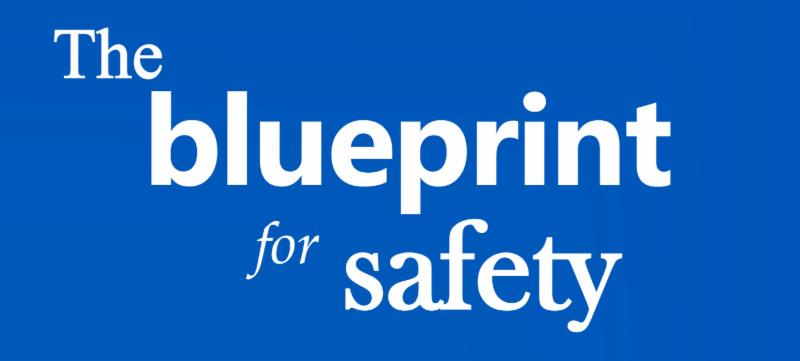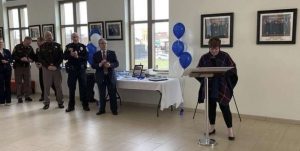
E-Newsletter on Reforming Criminal Justices Responses to Battering
The Blueprint Bulletin provides concrete tools and information to support your work. Each issue features foundational information about the Blueprint for Safety model, updates on Blueprint communities, and ideas about how to identify and address inequities in case outcomes. Praxis can advise you on the adaptation and implementation of the Blueprint and/or provide assistance on using aspects of the Blueprint model in your community. Access our Blueprint Clearinghouse to learn more about Blueprint training, consulting, information, strategies, and research.
Congratulations to Midland County, Michigan!
The Advocacy Initiated Response in Marquette County, MI
Resources for Blueprint Advocacy
Contact Us
 Congratulations to Midland County, Michigan!
Congratulations to Midland County, Michigan!

Midland County, Michigan launched its Blueprint in April 2019. Blueprint partners and community members met at the Midland County Courthouse to recognize the extensive work undertaken since 2015 by Blueprint partner agencies, including Shelterhouse (the local shelter, counseling and advocacy agency serving survivors of domestic violence and sexual assault), the Midland Police Department, Midland County Sheriff’s Office, and the Midland County Prosecuting Attorney’s Office, to enhance the local response to domestic violence crimes. The implementation of the Blueprint for Safety in Midland County includes law enforcement asking victims the Blueprint risk assessment questions during investigations and new officers and deputies receiving domestic violence training at Shelterhouse. The launch celebration was also attended by Office on Violence Against Women Program Specialist Brenda Auterman.
Midland Daily News Features Midland’s Launch
 The Advocacy Initiated Response in Marquette County, MI
The Advocacy Initiated Response in Marquette County, MI
Research demonstrates that survivors experience better outcomes when linked with confidential, community-based advocacy: psychological distress is reduced, and court outcomes are enhanced. The Advocacy Initiated Response (AIR) is a model for connecting victims to support, information and advocacy as soon as possible following law enforcement intervention. Typically, victims will not call an advocate due to a simple referral by law enforcement, and they usually decline an offer to have an advocate contact them. Many victims, therefore, are without valuable advocacy support at a time when they are under a significant amount of stress, as well as injured, confused, and vulnerable to increased coercion and violence by the batterer. Under the AIR model, law enforcement officers that respond to a domestic violence incident contact the local community-based advocacy program to share the victim’s contact information and inform the victim that an advocate will reach out to them directly. 
Blueprint communities are encouraged to implement AIR to increase the connections between survivors and community-based advocates. When an advocate initiates contact to a survivor and offers confidential services the survivor has the right to refuse but most are willing to talk, at least once, to an advocate. This opportunity can lay the foundation for continued involvement in the criminal case and ongoing individual support; thereby increasing safety for more victims. Marquette County Blueprint for Safety Advocate, Genna McCormick, learned the value of this approach firsthand when she started collecting data to better understand the impact of AIR on local survivors of domestic violence.
In Marquette County, there are eight separate law enforcement agencies that have each committed to a working agreement with local community-based advocacy program, the Women’s Center, to implement AIR. When possible, responding officers initiate a crisis call at the scene of the incident to a Women’s Center 24-hour, on-call advocate, passing the phone to the victim for immediate outreach and support. Then Genna, as the Blueprint Advocate, makes a follow-up call to the victim within two days. In cases where a crisis call is not possible, the officer prepares an AIR referral form for the Women’s Center with a basic description of the incident, whether or not an arrest has been made, and the victim’s contact information so that Genna or another available advocate is able to make a follow-up call to the victim as soon as possible.
At the start of Genna’s coordination of the Marquette AIR in November 2018, she discovered that not only were survivors reluctant to speak with an advocate at times, but advocates and officers were also not fully or consistently implementing the AIR approach. Many advocates believed that, in the spirit of victim autonomy, if a victim indicated to officers that they did not want to be contacted by advocacy, the victim’s wishes should be respected, and no follow-up call should be made. In some cases where the victim declined advocacy outreach, but circumstances suggested advocacy would be helpful, officers were uncertain about whether they should still refer a victim to the Women’s Center. (for more discussion on this common concern see Praxis’ article on proactively contacting a victim.)
Genna has implemented a few important changes to the Marquette AIR program to increase the consistent application of the AIR protocol. First, Genna revised the response protocol for advocates directing them to make a follow-up call to survivors for 100% of AIR cases referred by the police regardless of whether an initial crisis call occurred on-scene or not. This change alone has dramatically increased the number of survivors Women’s Center has been able to support. Second, to address the reluctance of advocates to follow this protocol, she analyzed existing data over a 6-month period, from January 2018 to June 2018, and discovered that advocate contact with survivors proportionally increases their access to services, as presented in the following compelling chart.
| Advocate Contact with Victims | Likelihood of Victim Accessing Services |
|
No contact (on-scene or after police investigation) |
0% of victims accessed services |
|
1 contact (on-scene or after police investigation) |
50% of victims accessed services |
|
2 contacts (on-scene or after police investigation) |
70% of victims accessed services |
This analysis clearly indicates the efficacy of AIR linking survivors with crucial advocacy services and has reduced concerns Marquette advocates previously had about making follow-up calls to survivors.
Genna notes that some survivors express displeasure about being called, but the Women’s Center has still experienced an overwhelmingly positive response. If the survivor is provided with an opportunity to express their feelings about the advocate’s call – be they good or bad – then assured that the advocate contact is confidential in order to provide information and offer support, most survivors readily engage. Genna has also found that it is equally important for the advocate to offer the survivor the option of engaging, emphasizing that the contact is not a demand that they come to the Women’s Center.
Genna has created a simple list of Women’s Center services for system practitioners and others in the community to increase awareness that they offer more than just shelter and counseling. Highlights of the Marquette County AIR include:
- Identifying and connecting the victim to Women’s Center services that fit the needs of the victim;
- Informing the victim that the prosecutor’s office will be sending a letter in the mail to them;
- Informing the victim that the Blueprint Advocate will be tracking the case as it moves through the system, even if the victim does not want to access services;
- Providing the Blueprint Advocate’s contact information so the victim can receive updates on their case, even if the victim does not want to access services;
- Improved coordination, relationships and trust between advocacy and law enforcement;
- Expansion of AIR agreements beyond law enforcement to include referrals for victims of battering to the Women’s Center by the local homeless services agency, child protection services and hospital.
To learn more, to go Make the Call A Toolkit for Advocacy Programs to Implement Advocacy-Initiated Response to Domestic Violence Crimes
 Resources for Blueprint Advocacy
Resources for Blueprint Advocacy
Blueprint for Safety Advocate – Role, Responsibilities and Skills
– Appendix 14 of A Guide to Becoming a Blueprint Community
The Blueprint for Safety is grounded in the lived experiences of survivors of battering. One key to ensuring that criminal legal system responses to domestic violence stay grounded in survivors’ lived experiences is to secure a Blueprint Advocate to work side-by-side with the community’s Blueprint Coordinator. The Blueprint Advocate has a central leadership role in:
- Representing the voices and experiences of survivors in all stages of the Blueprint process and implementation, from practice assessment and policy development to training and ongoing monitoring;
- Balancing systems change advocacy with crisis advocacy for individual survivors;
- Tracking and documenting what occurs in domestic violence cases as victim/survivors move through the system, including case outcomes and probationary supervision;
- Developing a survivor’s advisory group and holding survivor focus groups to collect and maintain knowledge of the full scope and scale of battering in the community;
- Identifying and supporting relationships between the Blueprint and other community-based organizations representing populations that experience inequitable outcomes from system intervention;
- Regularly meeting and advising the Blueprint Coordinator and the Blueprint Adaptation/Implementation Team; and
- Coordinating, establishing and implementing an Advocacy-Initiated Response across their local criminal legal system.
This Make the Call Toolkit offers a free, on-demand resource for advocacy programs to explore, adapt, and implement the AIR model to connect victims of battering with community-based advocacy as soon as possible after law enforcement has responded to a domestic violence 911 call. Use it to learn about the model and consider key questions for advocacy programs exploring whether and how to implement AIR. It will take 20-30 minutes to read the content, with 12 short videos (each approximately a minute and a half in length) available for viewing. Links are also available to related research, articles, and other resources to increase the knowledge and capacity of advocacy programs. The end of the Toolkit provides templates for policies and procedures for adaptation.
Praxis is also available to help if you want individual support to implement AIR in your community: contact info@praxisinternational.org.
 Contact us for more information
Contact us for more information
Blueprint for Safety Team
info@praxisinternational.org
This project was supported by Grant No. 2015-TA-AX-K032 awarded by the Office on Violence Against Women, U.S. Department of Justice. The opinions, findings, conclusions and recommendations expressed here are those of the author(s) and do not necessarily reflect the views of the U.S. Department of Justice.

